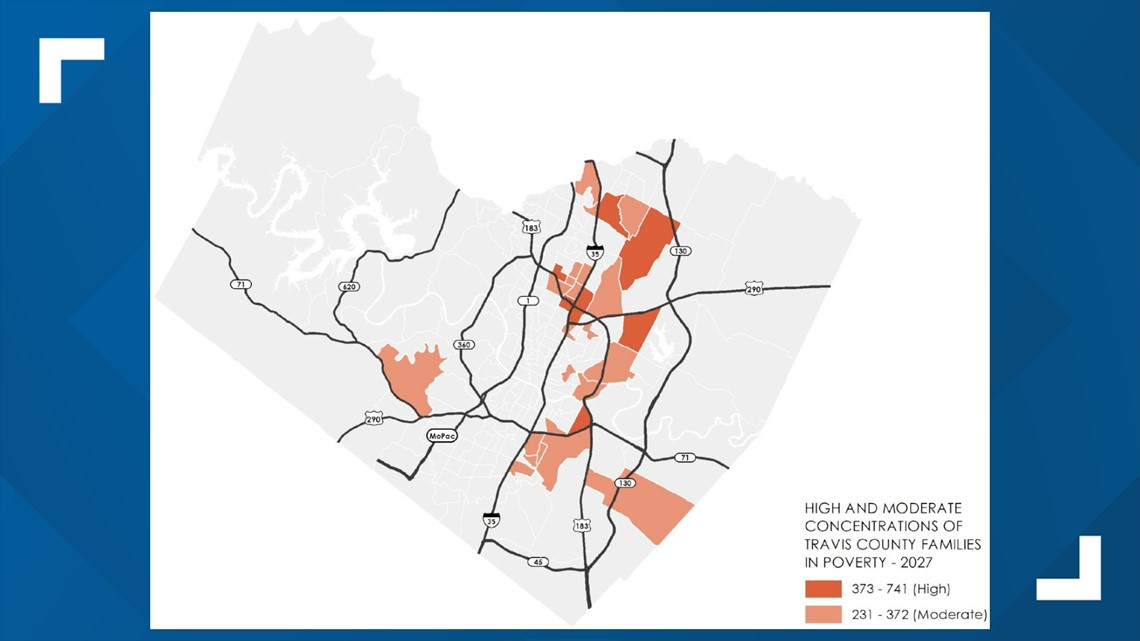TRAVIS COUNTY, Texas — Central Health has released its 2022 Demographic Report, which breaks down "where inequities are most prevalent throughout Travis County."
The report looked at where people with low income live, the barriers they face when it comes to health care and most common illnesses.
Below are some of the key findings from the report:
- High cost of living or affordability is not just an Austin issue but impacts Travis and surrounding counties
- Austin is considered an access point for health care, affordable housing, public transportation and social services
- Regardless to to proximity of a clinic, hospital or service, access continues to be a major problem
- People impacted by the most health equity issues and demographic differences of those living in East Austin and Black patients
“Central Health will use this report, along with community input, to implement our Healthcare Equity Plan to address the most pressing health equity needs in the region,” Central Health President and CEO Mike Geeslin said. “The demographic report findings will help guide our work to create a better healthcare system that gives historically marginalized communities a fair shot at leading healthier lives.”
Across Travis County, the report looked at the poverty line.
"75 percent of families with incomes living in poverty in Travis county live along the I-35 corridor, there is poverty throughout all areas," said Central Health Chief Strategy Officer Monica Crowley.
The report found a total of 23,655 Travis County families – 7.8% of all families in the county – live at or below the Federal Poverty Level (FPL), which is $27,750 for a family of four.
“Families with low income can’t just pick up and move outside of Austin or to a nearby county and find relief. Affordability is a region-wide issue,” said Crowley. “And even as Austin becomes less affordable, it is becoming a more important access point for safety-net programs, services, and infrastructure aimed at helping people with low income."
Within Travis County, there were nine areas of focus that were reported to have high and moderately high levels of poverty over the next five years. Those areas are:
- Colony Park
- Del Valle
- East Central Austin
- North Central Austin (Rundberg)
- North Travis County
- Northeast Austin (St. John’s/Windsor Hills)
- Oak Hill
- South Austin (Dove Springs)
- Southeast Austin (Montopolis)


This analysis looked at not only demographics but also social conditions such as housing, education, employment and transportation; chronic health conditions such as cardiovascular disease and diabetes; and residents enrolled in Central Health programs along with location to hospitals and clinics.
Chronic conditions were also highlighted in Central Health's report. These conditions or diseases are defined as lasting a year or more, needing ongoing medical attention and/or where daily living activities are limited. Central Health reported that they saw at least 40% of patients with one or more chronic conditions.
The report also highlighted that "Central Health identified a significant gap in specialty care for its patients which chronic conditions with service levels meeting less than 50% of the need."
Data showed that about 8% of the 111,000 people served by Central Health in Fiscal Year 2021 were unhoused. Out of those patients experiencing homelessness, 57% reported having at least one chronic condition.
To help with this, Central Health launched a medical respite program last March. This program provides short-term residential care to unhoused people.
"Medical respite is a critical stabilizing force for individuals experiencing homelessness because healing is impossible without having a safe place to recuperate," said Dr. Audrey Kuang, Central Health's director of high-risk populations. "It gives individuals an opportunity to heal from their acute medical illness while also working on their social needs – like housing and benefits – and behavioral health needs. "
In the respite program, patients receive medical care and social need support in a safe environment. In 2023, Central Health intends to double the number of beds in the respite program.
“The analysis from this report will inform our Healthcare Equity Plan for years into the future” said Dr. Charles Bell, Central Health's Board of Managers chairperson. “Inequities in our healthcare system were created over the course of decades, if not centuries, and it will take time and very focused intentional work by our entire community to correct those inequities.”
Read the full 2022 Demographic Report.

